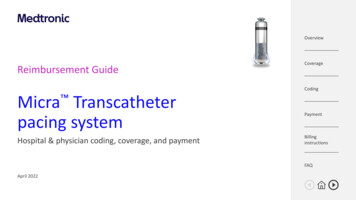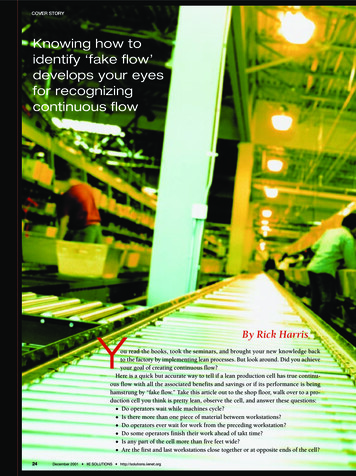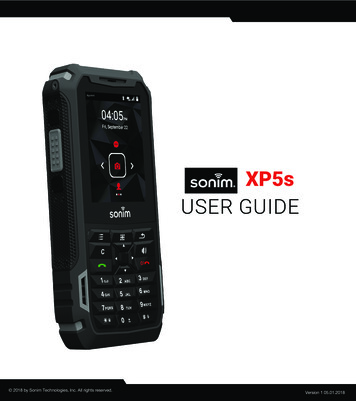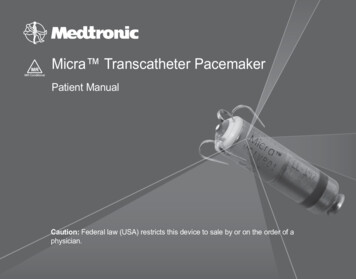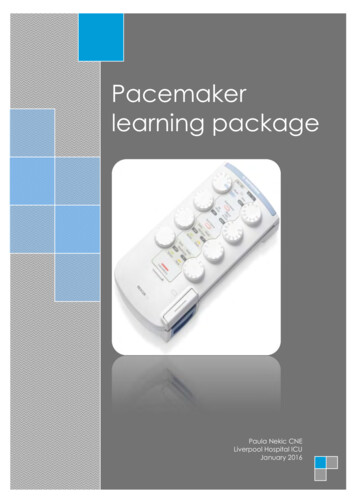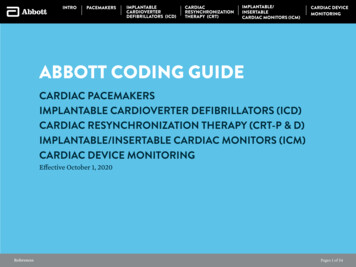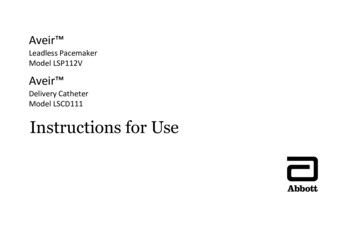
Transcription
Aveir Leadless PacemakerModel LSP112VAveir Delivery CatheterModel LSCD111Instructions for Use
CAUTION: Federal (USA) law restricts this device to sale by or on the order of a physician.WARNING: This product can expose you to chemicals including ethylene oxide, which is known tothe State of California to cause cancer and birth defects or other reproductive harm. For moreinformation, go to www.P65Warnings.ca.gov. Indicates a trademark of the Abbott group of companies.‡ Indicates a third-party trademark, which is property of its respective owner.Pat. http://www.abbott.com/patents 2021 Abbott. All Rights Reserved.
ContentsPrescription and Safety Information.1Product Description .19Instructions for Use. .30Managing and Following Patients .57Specifications and Characteristics.61Data Security. .73Technical Support.74Symbols.75i
ii
Prescription and Safety InformationRead this section to gather important prescription and safety information.Intended UseThe Aveir Leadless Pacemaker (LP) is designed to provide bradycardia pacing as a pulse generator withbuilt-in battery and electrodes for implantation in the right ventricle. The LP is intended to provide sensingof intrinsic cardiac signals and delivery of cardiac pacing therapy to the target patient population.The Aveir Delivery Catheter is intended to be used in the peripheral vasculature and the cardiovascularsystem to deliver and manipulate an LP. Delivery and manipulation includes implanting an LP within thetarget chamber of the heart.Indications for UseThe Aveir Leadless Pacemaker system is indicated for patients with significant bradycardia and: Normal sinus rhythm with rare episodes of A-V block or sinus arrestChronic atrial fibrillationSevere physical disabilityRate-Modulated Pacing is indicated for patients with chronotropic incompetence, and for those who wouldbenefit from increased stimulation rates concurrent with physical activity.MR Conditional Aveir Leadless Pacemaker is conditionally safe for use in the MRI environment and1
according to the instructions in the MRI-Ready Leadless System Manual.Aveir Delivery Catheter: The Aveir Delivery Catheter is intended to be used in the peripheral vasculatureand the cardiovascular system to deliver and manipulate an LP. Delivery and manipulation includeimplanting an LP within the target chamber of the heart.Aveir Link Module: The Aveir Link Module is intended to be used in conjunction with a Merlin PCSProgrammer to interrogate and program an Aveir LP and to monitor LP function during an implant,retrieval, or follow-up procedure.2
ContraindicationsUse of the Aveir Leadless Pacemaker is contraindicated in these cases: Use of any pacemaker is contraindicated in patients with a co-implanted ICD because high-voltageshocks could damage the pacemaker and the pacemaker could reduce shock effectiveness. Single-chamber ventricular demand pacing is relatively contraindicated in patients who havedemonstrated pacemaker syndrome, have retrograde VA conduction, or suffer a drop in arterial bloodpressure with the onset of ventricular pacing. Programming of rate-responsive pacing is contraindicated in patients with intolerance of high sensordriven rates. Use is contraindicated in patients with an implanted vena cava filter or mechanical tricuspid valvebecause of interference between these devices and the delivery system during implantation. Persons with known history of allergies to any of the components of this device may suffer an allergicreaction to this device. Prior to use on the patient, the patient should be counseled on the materials(listed in Product Materials (page 71)) contained in the device and a thorough history of allergies mustbe discussed.For the MRI contraindications for patients implanted with Aveir Leadless Pacemaker, refer to the MRIReady Leadless System Manual.There are no contraindications for use of the Aveir Link Module3
Clinical BenefitThe Aveir Leadless Pacemaker system offers all the clinical benefits provided by traditional pacemakers: Sensing the heart’s intrinsic signals and delivering cardiac pacing therapyLong-term management of chronic symptomatic sinus bradycardia and various forms of atrioventricularconduction abnormalities Improved health-related quality of life (QOL) and decreased morbidity and mortalityThe Aveir Leadless Pacemaker system provides additional benefits when compared to a traditional singlechamber transvenous lead and IPG pacemaker, including: No lead-related complications (such as infection, lead fracture, or insulation problems)No pocket-related complications (such as infection, skin erosion, or keloid formation)Elimination of pectoral scars and generator bulgeImproved health-related quality of life (QOL)The Aveir Leadless Pacemaker system also enables patients to have the option to undergo an MRI scan,when clinically necessary, under defined conditions for use.4
Patient Target GroupThe Aveir Leadless Pacemaker is intended to treat the same patient population as the conventional singlechamber pacemaker does. The single-chamber pacing therapy is specifically recommended for: Symptomatic patients with atrioventricular (AV) block who have chronic atrial fibrillation (AF) or otheratrial tachyarrhythmia (AT) or when maintenance of AV synchrony during pacing is not necessary. Select patients with AV block who require permanent pacing in whom frequent ventricular pacing is notexpected, or who have significant comorbidities that are likely to determine clinical outcomes and thatmay limit the benefit of dual chamber pacing. Symptomatic patients with sinus node dysfunction (SND) with evidence for impaired AV conduction orconcern over future development of AV block, while maintaining AV synchrony during pacing is notnecessary. Symptomatic patients with SND in which frequent ventricular pacing is not expected or the patient hassignificant comorbidities that are otherwise likely to determine the survival and clinical outcomes. Patients with atrial fibrillation and AV block who have an indication for permanent pacing with a LVEFbetween 36% and 50% and are expected to require ventricular pacing less than 40% of the time andwhere AV synchrony during pacing is not needed.Leadless pacing therapy can also be recommended for patients with difficult upper extremity venous accessor at increased risk for infection (for example, hemodialysis patients, history of recurrent device infections).5
Physicians are responsible for selecting the appropriate pacing therapy for their patients. The decision isdirected by evidence-based guidelines.MRI Safety InformationThe Aveir Leadless Pacemaker is conditionally safe for use in the MRI environment when used according tothe instructions in the MRI-Ready Leadless System Manual (which includes equipment settings, scanningprocedures, and a listing of conditionally approved components). Scanning under different conditions mayresult in severe patient injury, death, or device malfunction.Pre-Implantation ConsiderationsConsider the following before implanting the Aveir Leadless Pacemaker.Co-existing active implantable medical devices. The LP has not been tested in the presence of otherelectrically-active, non-Aveir , implantable medical devices (such as neurostimulators). Patient evaluationand the decision to implant the LP should take into account the presence of other active implantabledevices and should include consultation with the involved physician(s) or manufacturer of the co-existingdevice.Refer to the Aveir Link Module Instructions for Use for additional safety information regarding possibleinterference with other active implantable devices during implantation or follow-up telemetry. For furtherquestions on co-existing Abbott Medical implantable devices, contact Abbott Medical Technical Support(page 74).6
WarningsThe following warnings apply to the Aveir Leadless Pacemaker:Prior surgical intervention. Careful consideration should be given to patients who have had cardiovascularor peripheral vascular surgery/intervention within the last 30 days because these patients may have ahigher risk of complications.Previous clinical events. Implant of an LP should not be attempted in the presence of an active perforation.Implant sites where a previous clinical event such as perforation or lead extraction with myocardial tissueremoval should be avoided as this may result in a higher rate of perforation.Risk of perforation. Do not put excessive forward pressure on the protective sleeve or the delivery catheterwhen implanting the LP because perforation may result.Do not turn the LP more than 1 1/2 turns during implantation, because perforation may result.Risk of dislodgement. Use of an LP could involve risk of dislodgement resulting in inadvertent migration ofthe pacemaker into the lungs and possible compromised pulmonary reserve.Contact between devices. When implanting a new LP in the presence of a previously-implanted LP, the LPsshould not be touching. The consequences of potential short-term and long-term mechanical and electricalinteractions between the LPs are not known.During the implant procedure, avoid contact between the delivery catheter or its attached LP and anypreviously-implanted LP as this could result in dislodgement of the existing LP and possible embolization.7
Do not implant a new LP in the presence of an implanted transvenous lead because this has not beentested.When implanting a new traditional implant (pacemaker or ICD) in the presence of a previously-implanted LP,the transvenous leads associated with the new implant should not come in contact with the LP. Thecombination of a deactivated LP and a transvenous lead has not been tested and could result in patientinjury.Chronic retrievals. Limited testing has been performed for retrieval of a chronically implanted LP. Attemptedremoval of an LP that has been implanted chronically could result in patient injury.PrecautionsThe following precautions apply to the Aveir Leadless Pacemaker:Patient selection. Patients with coagulopathy, including those who are chronically anticoagulated, or otherconditions that could add significant risk in the unlikely event of surgical management of an incident such asperforation, should be evaluated carefully for suitability for leadless pacing.Cover the helix during implantation. Do not advance the LP through the vasculature without the deliverycatheter's protective sleeve fully covering the LP helix. Damage to the LP helix and injury to peripheralstructures and heart structures may occur if the LP helix is not covered.Use fluoroscopy to confirm LP placement. Confirm the placement of the LP at the desired implant site inthe endocardium of the right ventricle, via multiple plane fluoroscopy prior to release of the LP from the8
delivery catheter, to verify that inadvertent placement of the LP through a patent foramen ovale or septaldefect did not occur.Use by a single operator. When the LP is in the heart, the delivery catheter should only be manipulated by asingle operator.LP deployment. Do not turn the LP release knob until ready to deploy the LP after fixation in theendocardium; otherwise, loss of pacing and/or embolization could result.Storage and Handling Store the LP at room temperature, 25 C (77 F). Excursions are permitted between 15 C and 30 C (59 Fand 86 F).During transportation and handling, the LP can be safely exposed to temperatures between -20 C and60 C (-4 F and 140 F) that last up to 24 hours. Storage outside of this range may result in LP reset. Store the LP in a clean area, away from magnets, kits containing magnets, and sources ofelectromagnetic interference to avoid device damage. Do not implant an LP that has been dropped on a hard surface while outside of its intact shelf package,or from a height of more than 24 inches (61 cm) while within its intact shelf package. Sterility, integrity,or function cannot be guaranteed under these conditions, and the LP should be returned to AbbottMedical for inspection. Keep the delivery catheter in a cool, dry place. Do not expose to sunlight.9
SterilizationThe package contents have been sterilized with ethylene oxide before shipment. The LP and deliverycatheter are FOR SINGLE USE ONLY and are not intended to be resterilized.Any attempt to resterilize and reuse may compromise the integrity of this system. Adverse effects associatedwith resterilization and reuse of components may include, but are not limited to: Local and/or systemic infectionMechanical damageInaccurate functionalityDo not implant the LP when the sterility indicator within the inner package is purple, because it might nothave been sterilized, or when the storage package has been pierced or altered, because this could haverendered it non-sterile.Environmental and Medical Therapy HazardsAbbott Medical devices are equipped with special shielding and filters which significantly reduce theadverse effects of electromagnetic interference (EMI) on the operation of the LP.Patients should be directed to exercise reasonable caution in avoidance of strong electric or magnetic fields.If the LP inhibits or reverts to asynchronous operation while in the presence of EMI, the patient shouldmove away from the EMI source or turn the source off.Advise patients to seek medical guidance before entering environments which could adversely affect theoperation of the LP, including areas protected by a warning notice preventing entry by pacemaker patients.10
Medical Procedures and EnvironmentsIn general, pacemaker patients should not be exposed to hospital equipment that produces highelectromagnetic field strength signals, such as diathermy machines and electrosurgical units. Exposure todevices that generate strong electric or magnetic interference (EMI) could cause LP reset, malfunction ordamage. Contact Abbott Medical Technical Support (page 74) for additional information.External defibrillation. The electronic circuitry in the LP provides protection from defibrillation discharges.Nevertheless, do not place defibrillator paddles directly over the LP. Following defibrillation, ensure that theLP is operating correctly.Magnetic resonance imaging (MRI). Leadless pacemakers are conditionally safe for use in the MRIenvironment when used according to the instructions in the MRI-Ready Leadless System Manual.Ionizing Radiation. Therapeutic ionizing radiation (for example, used in linear accelerators and cobaltmachines) can permanently damage the LP's circuitry. The effect of ionizing radiation is cumulative; thepotential for damage to the LP is proportional to the patient’s total radiation dosage. If the patient must beexposed to ionizing radiation, protect the LP during the procedure with local radiation shielding. Before andafter exposure to radiation, evaluate the LP operation to identify any adverse consequences.Transcutaneous electrical nerve stimulation (TENS). To reduce the possibility of interference with LPoperation, place the TENS electrodes close to one another and as far from the LP as possible. Beforeallowing unrestricted use of TENS in a home or other setting, screen the patient in a monitored environmentfor possible interaction.11
Therapeutic diathermy. Avoid diathermy, even if the LP is programmed off, as it may damage tissue aroundthe implanted electrodes or may permanently damage the LP.Electrosurgical cautery. This can induce ventricular arrhythmias and/or fibrillation or may causeasynchronous or inhibited LP operation. If use of electrocautery is necessary, the current path and groundplate should be kept as far away from the LP as possible. The axis of the electrocautery should beperpendicular to the electrode axis. A bipolar cauterizer may minimize these effects. Followingelectrocautery, conduct a thorough assessment of the LP.RF ablation. Delivery of intra-cardiac radiofrequency (RF) energy during an RF ablation procedure in patientswith a cardiac implantable electronic device may cause: Pacing above or below the programmed rate Programming an asynchronous, non-rate responsive pacing mode prior to the RF ablation procedureReversion to asynchronous operationLP electrical resetPremature triggering of the recommended replacement (RRT) indicatorPermanent LP malfunction and/or damageRF ablation risks may be minimized by:Avoiding direct contact between the ablation catheter tip and the LPPositioning the grounding patch/pad so that the current pathway does not pass through or near the LP(for example, placing the ground plate under the patient’s buttocks or legs)12
Having a programmer system readily availableMonitoring the patient during and immediately after the procedureHaving external pacing or defibrillation equipment availableTherapeutic ultrasound. The LP should not be exposed to therapeutic levels of ultrasound energy, as the LPcan inadvertently concentrate the ultrasound field and cause harm that might not be immediatelydetectable. Diagnostic ultrasound treatment is not known to affect the operation of the LP.Temporary pacing. Care should be taken when implanting a new LP in conjunction with a temporary pacinglead to avoid any electrical or mechanical interaction.Patient EnvironmentsAdvise patients to exercise reasonable caution in avoidance of strong electric or magnetic fields. Exposure tothese strong electric or magnetic fields could result in LP reset.If the LP inhibits or reverts to asynchronous operation while in the presence of electromagnetic interference(EMI), the patient should move away from the EMI source or turn the source off.Advise patients to seek medical guidance before entering environments that could adversely affect theoperation of the LP, including areas protected by a warning notice preventing entry by pacemaker patients.High-voltage transmission lines and equipment, arc or resistance welders, induction furnaces, and similarequipment may generate substantial EMI fields which may interfere with LP operation.13
Communication equipment such as microwave transmitters 1, linear power amplifiers, or high-poweramateur transmitters may generate sufficient EMI to interfere with LP operation. Advise patients to moveaway from this equipment to resume normal LP operation.Home appliances that are in good working order and properly grounded do not usually produce enoughEMI to interfere with LP operation. Electric vibrators, razors, and hand tools held directly over the devicemay disturb LP operation.Electronic Article Surveillance (EAS). Advise patients that Electronic Article Surveillance (EAS) systems suchas those at the point of sale and entrances or exits of stores, libraries, banks, etc., emit signals that mayinteract with pacemakers. It is very unlikely that these systems will interact with their LP significantly.However, to minimize the possibility of interaction, advise patients to simply walk through these areas at anormal pace and avoid lingering near or leaning on these systems.1Home appliance microwave ovens do not interfere with LP operation.14
No Pacer symbol. Caution patients implanted with an LP to avoid areas marked with the No Pacer symbol.Figure 1. No Pacer symbol15
Cellular phones. The LP has been tested for compatibility with handheld wireless transmitters in accordancewith the requirements of ISO 14117. This testing covered the operating frequencies (385 MHz-3 GHz). Basedon the results of this testing, the normal operation of cellular phones should not affect the LP. Advise patients not to carry a cellular phone in a breast pocket or other location if they are over the LP.Some accessories for cellular phones may contain magnets, such as cases with magnetic clasps. SeePacing Rates Following Magnet Detection (page 70). Advise patients to avoid interference between cell phones or smart watches and the LP by keepingthem at least 15 centimeters (6 inches) away from the LP.Portable electronic devices. Advise patients not to carry electronic portable devices such as e-cigarettes, or key cards, credit cards orother items with magnetic strips in their breast pocket or near the heart. Advise patients not to carry earbuds or headphones in their breast pocket or near the heart, and not toallow earbuds or headphones to drape around the patient's neck so they hang on the chest. Thesedevices may contain a magnet or magnetic material, or may emit RF signals that can interfere with theLP.For further questions, contact Abbott Medical Technical Support (page 74).Environmental conditions. Advise patients to avoid environments that may cause a sudden change in bodytemperature, which could affect rate response if Sensor mode is turned on.16
The LP is designed to withstand absolute ambient pressures between at least 50 kPa (0.5 atm) and 304 kPa(3 atm). Advise patients to avoid environments that could subject the LP to atmospheric pressures outsideof this range.Adverse EventsPotential complications associated with the use of the Aveir Leadless Pacemaker system are the same aswith the use of single chamber pacemakers with active fixation pacing leads including, but not limited to: Cardiac perforationCardiac tamponadePericardial effusionPericarditisValve damage and/or regurgitationHeart failurePneumothorax/hemothoraxCardiac arrhythmiasDiaphragmatic/phrenic nerve stimulation / extra-cardiac stimulationPalpitationsHypotension17
SyncopeCerebrovascular accidentInfectionHypersensitivity reaction to device materials, medications, or direct toxic effect of contrast media onkidney function Pacemaker syndrome Loss of capture or sensing due to embolization or fibrotic tissue response at the electrode Battery malfunction/ premature battery depletionInability to interrogate or program the LP due to programmer or LP malfunctionIntermittent or complete loss of pacing and/or sensing due to dislodgement or mechanical malfunctionof the LP (non-battery related)Increased capture thresholdInappropriate sensor responseInterruption of desired LP function due to electrical interference, either electromyogenic orelectromagneticDevice-related complications:18
–Premature deployment–Device dislodgement/embolization of foreign material–Helix distortion DeathAs with any percutaneous catheterization procedure, potential complications include, but are not limited to: Vascular access complications; such as perforation, dissection, puncture, groin painBleeding or hematomaThrombus formationThromboembolismAir embolismLocal and systemic infectionPeripheral nerve damageGeneral surgery risks and complications from comorbidities; such as hypotension, dyspnea, respiratoryfailure, syncope, pneumonia, hypertension, cardiac failure, reaction to sedation, renal failure, anemia,and death19
Incident ReportingIf, in the course of use of this device, you have reason to believe that a serious incident occurred, pleasereport it to the manufacturer. For customers in the European Union, report the serious incident to yournational authority as well as to the manufacturer.Product DescriptionThis section describes the Aveir Leadless Pacemaker and Aveir Delivery Catheter.Table 1. Product modelsNameAveir LeadlessPacemakerModelLSP112VAveir Delivery Catheter LSCD111DescriptionLeadless pacemakerRV (right ventricular)Delivery catheterPackage ContentsThe LP and delivery catheter are supplied in individual sterile packs: A pack that contains a tray that holds the LP inside the loading tool.A pack that contains a tray that holds the delivery catheter tray.The trays are sterile (via ethylene oxide), for single-use only, and may not be re-sterilized.20
If the sterile package has been compromised, do not use it. Contact Abbott Medical Technical Support(page 74) for return instructions.Leadless PacemakerThe Aveir Leadless Pacemaker (LP) provides bradycardia pacing as a pulse generator with a built-in batteryand electrodes for implantation in the right ventricle.As a leadless device, it does not need a connector, pacing lead, or pulse generator pocket. A distal nonretractable helix affixes the LP to the endocardium. Three additional features on the outside of the LPnosecone are designed to provide secondary fixation securement. Sensing and pacing occur between adistal electrode near the helix and the external can of the LP. The LP's proximal end has a feature for dockingto delivery and retrieval catheters, providing for repositioning and retrieval capability.The LP communicates bi-directionally with the programmer system via electrical signals conducted betweenthe implanted LP's electrodes and skin electrodes applied to the patient’s chest and connected to theprogrammer system. Consequently, the LP transmits signals using circuits and electrodes already providedfor pacing, with data encoded in pulses delivered during the heart’s refractory period.The LP senses right-ventricular blood temperature to provide an increase in pacing rate with increasedmetabolic demand.NOTE: The LP device electronics are designed to BE enabled by FUTURE software to support dual-chamberpacing in the future.21
Figure 2. Leadless pacemaker (LP)1. Docking button2. HelixThe tip electrode includes a single dose of dexamethasone sodium phosphate (DSP), intended to reduceinflammation.The LP is supplied contained inside the loading tool.Figure 3. Loading tool1.2.3.4.5.22Chamber iconLP inside loading toolLatchFunnelCurved wings
Delivery CatheterThe Aveir Delivery Catheter (delivery catheter) includes a steerable delivery catheter, an integrated guidingcatheter with a protective sleeve designed to protect an attached LP's fixation helix and electrode, and avalve bypass tool to dilate the 25 Fr inner diameter (ID) introducer sheath hemostasis valve and advance thesystem into the femoral vein.23
Figure 4. Delivery catheter1. Delivery catheter tip (page 26)2. Guide catheter with marker bands3. Flush/irrigation ports5. Valve bypass tool6. Guide catheter hub lock7. Delivery catheter handle (page 27)4. Valve bypass tool lock24
The delivery catheter provides a means to perform these actions during the implantation procedure: Attach and dock a separate LP pre-loaded in the loading toolPosition the protective sleeve over the LP's fixation helix and lock the sleeve into placeAdvance the LP from an access site in the groin (utilizing minimally invasive techniques) through thefemoral vein into the right ventricleHand inject contrast solution through the guide catheter flush port to its distal tipPull back the protective sleeve to expose the flexible section of the delivery catheterMap the endocardium with the docked LP to assess appropriateness of implant sitePosition the LP and rotate it to affix the LP's fixation helix to the endocardiumUndock the LP from the delivery catheter leaving the LP tethered to the delivery catheter to measurethresholds with minimal force transmission from the delivery catheterRe-dock to the delivery catheter, unscrew and reposition the LP, if necessary, for acceptable thresholdsDisconnect the LP from the tethers of the delivery catheter, leaving the LP implanted in theendocardium.Apart from the docking mechanism, the delivery catheter and its control system (handle) have the sameoperating principle as a conventional steerable catheter and control system.25
Figure 5. Delivery catheter1. Delivery catheter tip (page 26)2. Guide catheter with marker bands3. Flush/irrigation ports5. Valve bypass tool6. Guide catheter hub lock7. Delivery catheter handle (page 27)4. Valve bypass tool lock26
Figure 6. Delivery catheter tip1. LP2. Tethers3. Docking cap4. Protective sleeve27
Figure 7. Delivery catheter handle1. Flush/irrigation port2. Deflection lever3. Deflection brake4. LP control knob release buttons5. LP control knob6. LP release knob28
Compatible DevicesThe LP and delivery catheter are intended to be used with this compatible introducer:Table 2. Compatible deviceNameModelDescriptionAveir IntroducerLSN25301LSN2550125 Fr ID hydrophilic-coated introducer sheathRefer to the Aveir Introducer Instructions forUse.CAUTION: Do not use the LP and delivery catheter with other introducers; use with other introducershas not been tested and can damage the devices.The LP is intended to be used with these compatible programmer system components:Table 3. Compatible devicesNameModelDescriptionAveir Link Module LSL02Programmer communication unitRefer to the Aveir Link Module Instructions forUse.29
Table 3. Compatible devicesNameModelDescriptionMerlin PCS3650Patient care systemRefer to the Merlin Patient Care System User’sManual.CAUTION: Do not use the LP with other programmer systems because this could result in noprogramming or incorrect programming.CAUTION: Do not bring any external control devices, such as a Merlin PCS or Aveir Link Module, intothe scanner magnet room (Zone IV). These devices are considered MR Unsafe.If retrieval of an implanted LP becomes necessary, use this compatible retrieval catheter:Table 4. Compatible deviceNameModelD
Cover the helix during implantation. Do not advance the LP through the vasculature without the delivery . catheter's protective sleeve fully covering the LP helix. Damage to the LP helix and injury to peripheral . structures and heart structures may occur if the LP helix is not covered. Use fluoroscopy to confirm LP placement.


